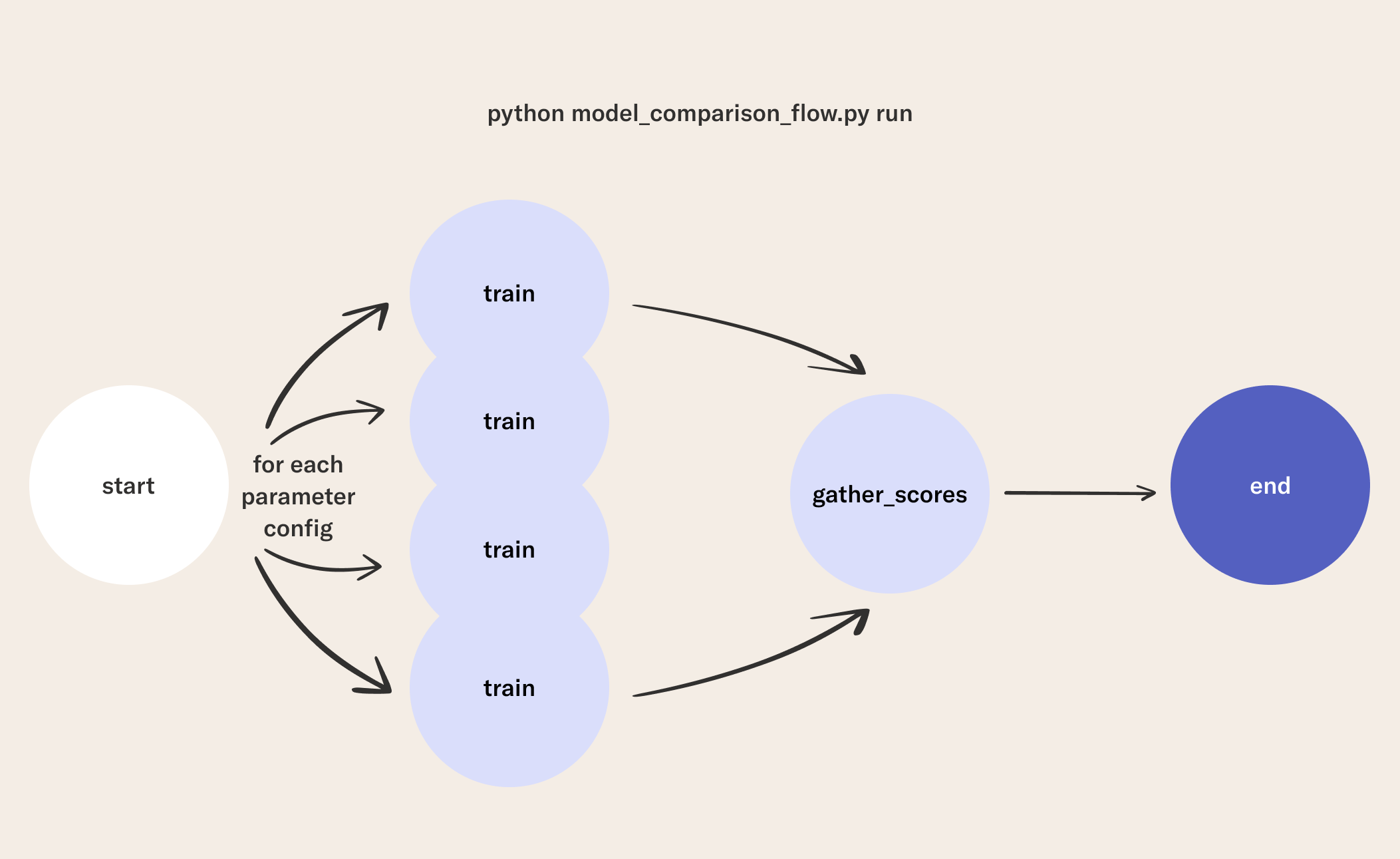Beginner Computer Vision: Episode 4
Now that you have a stable workflow for training and evaluating models, it is time to iterate. In this lesson, you will see how to build a flow that does a hyperparameter search. The search consists of checking the model's number of neurons in each layer. We will tune the neural network to have a different number of convolutional filters in each network. Metaflow will parallelize the training of one model for each hyperparameter configuration automatically while versioning the results of all training runs. After running the flow you will be able to fetch all hyperparameter values and metrics scores in any Python environment.
1Write a Tuning Flow
This flow shows how you can tune the cnn model. The flow includes
- A
startstep that loads data. - A
trainstep that trains and scores a model for each hyperparameter configuration.- Metaflow's foreach pattern is used to make this happen in parallel locally and in the cloud.
- A
gather_scoresstep that joins the results from each modeling step and stores the results in a Metaflow card visual. - An
endstep that saves the best model.

from metaflow import FlowSpec, step, Flow, current, card
from metaflow.cards import Image, Table
from tensorflow import keras
from models import ModelOperations
class TuningFlow(FlowSpec, ModelOperations):
best_model_location = ("best_tuned_model")
num_pixels = 28 * 28
kernel_initializer = 'normal'
optimizer = 'adam'
loss = 'categorical_crossentropy'
metrics = [
'accuracy',
'precision at recall'
]
input_shape = (28, 28, 1)
kernel_size = (3, 3)
pool_size = (2, 2)
p_dropout = 0.5
epochs = 5
batch_size = 64
verbose = 2
@step
def start(self):
import numpy as np
self.num_classes = 10
((x_train, y_train),
(x_test, y_test)) = keras.datasets.mnist.load_data()
x_train = x_train.astype("float32") / 255
x_test = x_test.astype("float32") / 255
self.x_train = np.expand_dims(x_train, -1)
self.x_test = np.expand_dims(x_test, -1)
self.y_train = keras.utils.to_categorical(
y_train, self.num_classes)
self.y_test = keras.utils.to_categorical(
y_test, self.num_classes)
self.param_config = [
{"hidden_conv_layer_sizes": [16, 32]},
{"hidden_conv_layer_sizes": [16, 64]},
{"hidden_conv_layer_sizes": [32, 64]},
{"hidden_conv_layer_sizes": [32, 128]},
{"hidden_conv_layer_sizes": [64, 128]}
]
self.next(self.train, foreach='param_config')
@step
def train(self):
from neural_net_utils import plot_learning_curves
self.model = self.make_cnn(
self.input['hidden_conv_layer_sizes'])
self.history, self.scores = self.fit_and_score(
self.x_train, self.x_test)
self._name = 'CNN'
self.plots = [
Image.from_matplotlib(p) for p in
plot_learning_curves(
self.history,
'Hidden Layers - ' + ', '.join([
str(i) for i in
self.input['hidden_conv_layer_sizes']
])
)
]
self.next(self.gather_scores)
@card
@step
def gather_scores(self, models):
import pandas as pd
self.max_class = models[0].y_train
results = {
'hidden conv layer sizes': [],
'model': [],
'test loss': [],
**{metric: [] for metric in self.metrics}
}
max_seen_acc = 0
rows = []
for model in models:
results['model'].append(model._name)
results['test loss'].append(model.scores[0])
for i, metric in enumerate(self.metrics):
results[metric].append(model.scores[i+1])
results['hidden conv layer sizes'].append(
','.join([
str(i) for i in model.input[
'hidden_conv_layer_sizes'
]
])
)
# A simple rule for determining the best model.
# In production flows you need to think carefully
# about how this kind of rule maps to your objectives.
if model.scores[1] > max_seen_acc:
self.best_model = model.model
max_seen_acc = model.scores[1]
rows.append(model.plots)
current.card.append(Table(rows))
self.results = pd.DataFrame(results)
self.next(self.end)
@step
def end(self):
self.best_model.save(self.best_model_location)
if __name__ == '__main__':
TuningFlow()
2Run the Tuning Flow
python tuning_flow.py run
3Visualize Results
python tuning_flow.py card view gather_scores
In this lesson, you saw how to extend your model training flows to tune hyperparameters in parallel. Whether you are building an ML platform or a workflow targeting a single application, it is important to consider your exploration budget and how you will improve models through processes like hyperparameter tuning. For example, here you can see an example of using Metaflow with more complex tuning algorithms via Optuna. In the next lesson, you will interpret the results of all the models you have trained thus far. See you there!